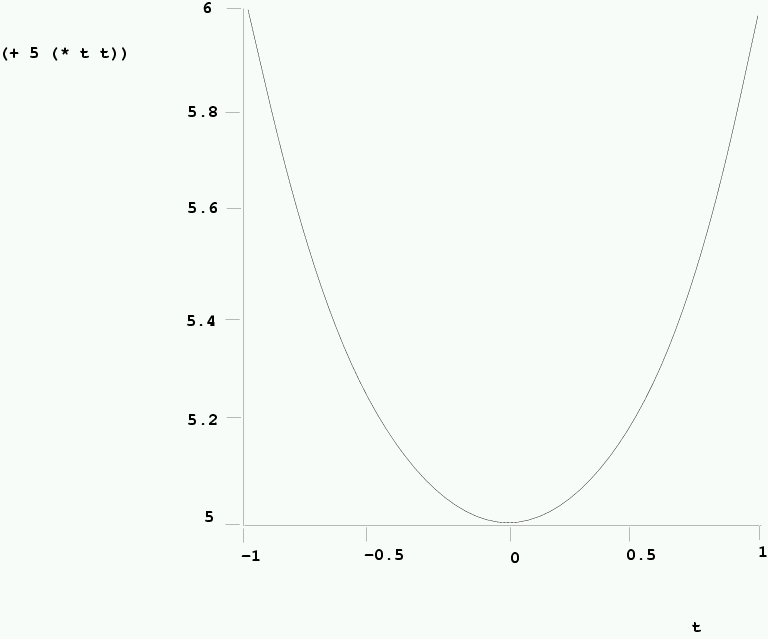To refresh your memory, these are the rules of derivatives. These are sufficient, when diligently applied, to take the derivative of any arithmetic expression.
(d/dx)x = 1where A and B are potentially complex arithmetic operations, f is a function, and f' is it's derivative (eg sin'(x) = cos(x), cos'(x)=-sin(x), exp'(x)=exp(x), log'(x)=1/x).
(d/dx)y = 0 (y a variable other than x, or a number)
(d/dx)(A+B) = (d/dx)A + (d/dx)B
(d/dx)(A-B) = (d/dx)A - (d/dx)B
(d/dx)(A*B) = A (d/dx)B + B (d/dx)A
(d/dx)(A/B) = (B (d/dx)A - A (d/dx)B)/(B*B)
(d/dx)(f(A)) = f'(A) (d/dx)A
Examples:
(diff 57 'x) ; 0 (diff 'a 'x) ; 0 (diff '(+ a b) 'x) ; 0 (diff 'x 'x) ; 1 (diff '(* a (* x x)) 'x) ; (* a (* 2 x)) (diff '(/ x a) 'x) ; (/ 1 a) (diff '(/ a x) 'x) ; (* a (/ -1 (* x x))) (diff '(+ a (* x x)) 'x) ; (* 2 x) (diff '(* (+ x 1) (+ x 2)) 'x) ; (+ (+ x 2) (+ x 1)) (diff '(* a (sin (* b x))) 'x) ; (* a (* b (cos (* b x))))(or different but equivalent results.)
(plot expr var n-samples x0 x1 xtics y0 y1 ytics) draws (using the turtle) a plot of the expression expr as a function of the variable var. The variable var ranges from x0 to x1, and the y-axis ranges from y0 to y1. The expression is evalutated at n-samples equally spaced points along the x-axis. The x-axis is has numbers at both the upper and lower ends of its range, and also at equally spaced intermediate points, to make a total of xtics numbers. The y-axis is similarly numbered. Both the x- and y-axes are also labeled, with var and a simplified version of expr, respectively.
So if you type (plot '(+ (+ 1 4) (* (* t 1) t)) 't 30 -1 1 5 5 6
6) you end up with something like this:

The plot should be drawn relative to the where the turtle is when you call plot, so it will be possible for the user to draw a couple plots next to each other if they so desire. And after drawing a plot, the turtle should end up at a location such that the user can immediately draw another plot without obscuring the first plot. Note: the variables turtle-x and turtle-y give the current location of the turtle. Although not essential, they may be helpful in making your plots relative to the starting location of the turtle.
It's okay if the curve extends below y0 or above y1, but you get extra credit for clipping it at those boundaries.
Examples:
(define f '(* (exp (- 0 s)) (sin (* 20 s)))) (plot f 's 30 0 4 5 -1 1 3) (plot (diff f 's) 's 30 0 4 5 -10 10 3) (plot (diff (diff f 's) 's) 's 30 0 4 5 -20 20 3)
Run wild.